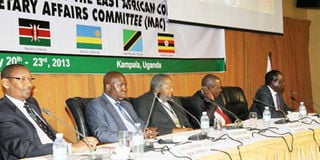Prime
East African central banks to rebuild forex reserves

Bank of Uganda governor Tumusiime -Mutebile (centre) at one of the ordinary meetings of the Monetary Affairs Committee of the East African Community recently. Sitting in Kampala last week, central bank governors resolved to rebuild their countries’ foreign exchange reserves so as to mitigate financial risks that may occur.
FILE PHOTO
What you need to know:
- Foreign exchange reserves are important indicators of ability to repay foreign debt.
Kampala.
The Eastern African Community (EAC) central bank governors have agreed on the policy of increasing their foreign exchange reserves to guard against any external shocks/risks facing the region’s economies.
Foreign exchange reserves are important indicators of ability to repay foreign debt, currency defence and are used to determine credit rating of nations.
In a joint communique issued by five governors of EAC member states at the end of the 20th ordinary meeting of the Monetary Affairs Committee (MAC) of EAC at Kampala Serena Hotel last week, they said global financial and economic developments continue to impact on the EAC economies.
The governors underscored the need to put in place safeguards to mitigate imminent risks.
“Governors reiterated the need to rebuild international reserve buffers and strengthen their financial sector regulatory frameworks to ensure financial stability,” the joint communiqué reads, in part.
The current state of foreign exchange reserves in EAC shows that they have foreign exchange reserves which can cover a reasonable period of future imports of goods and services.
In an interview with Daily Monitor, the Kenya central bank governor, Dr Patrick Njoroge, said having large amounts of foreign exchange reserves places the country in a safe position to mitigate financial risks that may occur.
On how much foreign reserves Kenya has, Dr Njoroge said: “The central bank of Kenya’s foreign exchange reserve was $7.878 billion as of July 7. This can cover 5.15 months of future imports of goods and services.”
The governor Bank of Tanzania, Prof Benno Ndulu, said some countries need to have large foreign exchange reserves because they import a lot of goods. He said: “Our foreign exchange level can cover 5.2 months of future imports of goods and services (but) cannot sit back and watch challenges facing the region.
The governor of National Bank of Rwanda, Mr John Rwangombwa, said Rwanda has foreign exchange reserves which can cover 4.2 future months of goods and services.
“Our foreign exchange reserve level is slightly below $1 billion but it can cover more than four months of future imports of goods and services,” he said.
Without mentioning the amount and exact period its foreign exchange can cover, the Burundi central bank governor, Mr Jean Ciza told Daily Monitor that Burundi’s foreign exchange reserve is adequate to cover a reasonable period of future imports of goods and services.
The stock of Uganda’s foreign exchange reserves as at June 7 amounted to $2.97 billion (Shs9.9 trillion), which the Bank of Uganda (BoU) says is equivalent to 4.4 months of future imports of goods and services.
The governor BoU, Mr Emmanuel Tumusiime Mutebile, said the competitive exchange rate policy has served Uganda very well.
The meeting, among other things, reviewed the progress on the implementation of decisions of the 19th ordinary meeting held in Zanzibar, Tanzania in August 2015.
Monetary Union
In 2013, the East African Community (EAC) heads of state signed a protocol establishing the EAC Monetary Union by 2024 with a single currency to facilitate trade and other activities within the region.The average economic growth in East Africa is projected at 5 per cent, which is higher than the sub-Saharan Africa growth of 3 per cent for this year.




